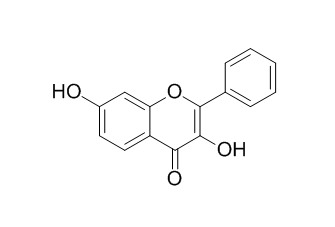7-Hydroxyflavonol
7-Hydroxyflavonol can inhibit E6 binding to FADD and caspase 8.
Inquire / Order:
manager@chemfaces.com
Technical Inquiries:
service@chemfaces.com
Tel:
+86-27-84237783
Fax:
+86-27-84254680
Address:
1 Building, No. 83, CheCheng Rd., Wuhan Economic and Technological Development Zone, Wuhan, Hubei 430056, PRC
Providing storage is as stated on the product vial and the vial is kept tightly sealed, the product can be stored for up to
24 months(2-8C).
Wherever possible, you should prepare and use solutions on the same day. However, if you need to make up stock solutions in advance, we recommend that you store the solution as aliquots in tightly sealed vials at -20C. Generally, these will be useable for up to two weeks. Before use, and prior to opening the vial we recommend that you allow your product to equilibrate to room temperature for at least 1 hour.
Need more advice on solubility, usage and handling? Please email to: service@chemfaces.com
The packaging of the product may have turned upside down during transportation, resulting in the natural compounds adhering to the neck or cap of the vial. take the vial out of its packaging and gently shake to let the compounds fall to the bottom of the vial. for liquid products, centrifuge at 200-500 RPM to gather the liquid at the bottom of the vial. try to avoid loss or contamination during handling.
Evid Based Complement Alternat Med.2020, 2020:1970349.
Pharm Biol.2016, 54(7):1255-62
Arch Toxicol.2024, 98(5):1415-1436.
Biol Pharm Bull.2023, 46(2):245-256.
J Basic Clin Physiol Pharmacol.2016, 27(1):1-8
Molecules.2019, 24(11):E2102
Acta Biochim Pol.2015, 62(2):253-8
J Pharmaceut Biomed2020, 178:112894
Bioorg Chem.2024, 145:107184.
Phytother Res.2023, 37(10):4587-4606.
Related and Featured Products
Bioorganic & medicinal chemistry letters, 2012, 22(5):2125-2129.
Small molecule inhibitors of the HPV16-E6 interaction with caspase 8.[Reference:
WebLink]
METHODS AND RESULTS:
High-risk strains of human papillomaviruses (HPVs) cause nearly all cases of cervical cancer as well as a growing number of head and neck cancers. The oncogenicity of these viruses can be attributed to the activities of their two primary oncoproteins, E6 and E7. The E6 protein has among its functions the ability to prevent apoptosis of infected cells through its binding to FADD and caspase 8. A small molecule library was screened for candidates that could inhibit E6 binding to FADD and caspase 8. Flavonols were found to possess this activity with the rank order of myricetin > morin > quercetin > kaempferol = galangin ≫ (apigenin, 7-Hydroxyflavonol, rhamnetin, isorhamnetin, geraldol, datiscetin, fisetin, 6-hydroxyflavonol). Counter screening, where the ability of these chosen flavonols to inhibit caspase 8 binding to itself was assessed, demonstrated that myricetin, morin and quercetin inhibited GST-E6 and His-caspase 8 binding in a specific manner.
CONCLUSIONS:
The structure–activity relationships suggested by these data are unique and do not match prior reports on flavonols in the literature for a variety of anticancer assays.



